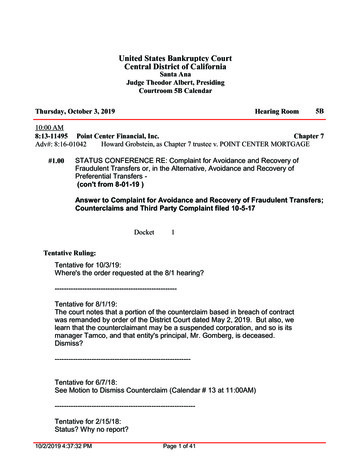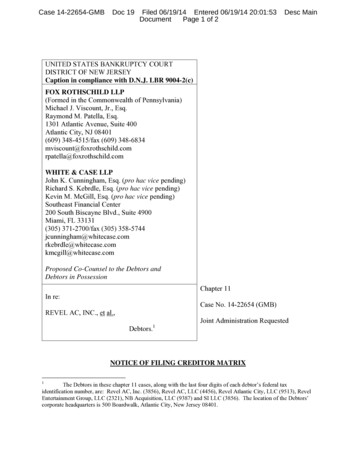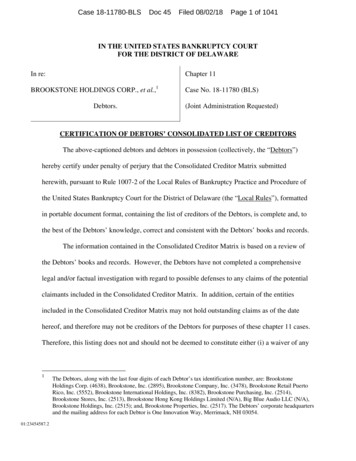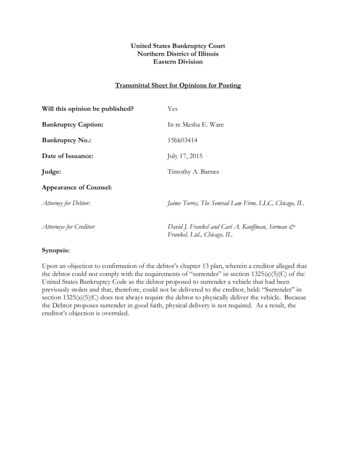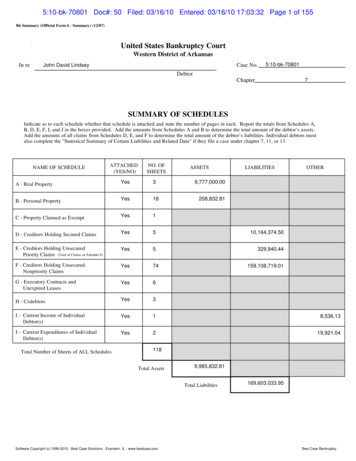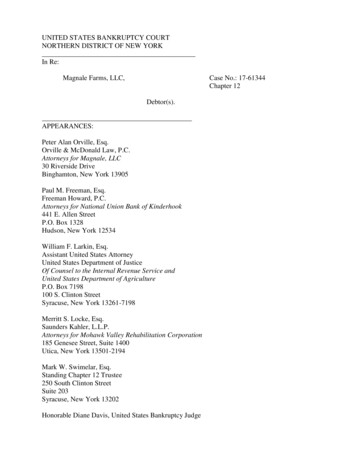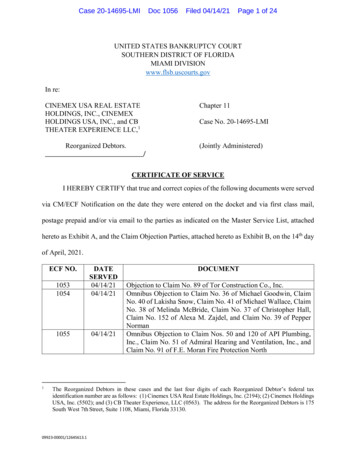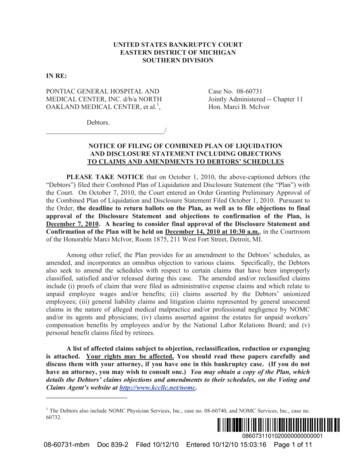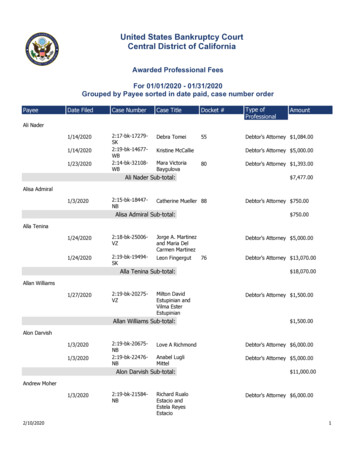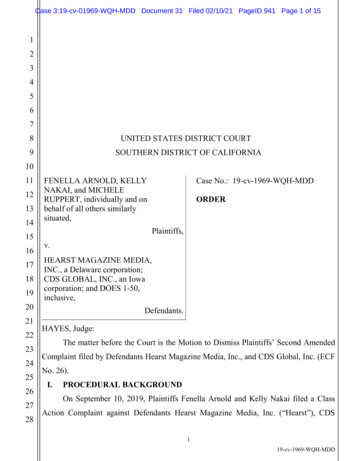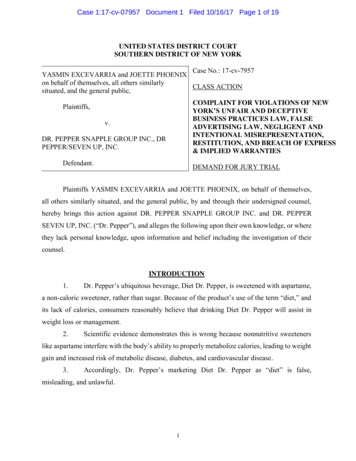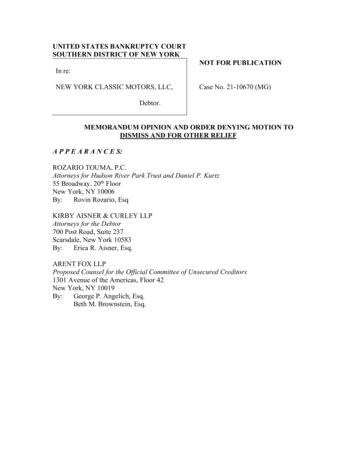
Transcription
UNITED STATES BANKRUPTCY COURTSOUTHERN DISTRICT OF NEW YORKNOT FOR PUBLICATIONIn re:NEW YORK CLASSIC MOTORS, LLC,Case No. 21-10670 (MG)Debtor.MEMORANDUM OPINION AND ORDER DENYING MOTION TODISMISS AND FOR OTHER RELIEFA P P E A R A N C E S:ROZARIO TOUMA, P.C.Attorneys for Hudson River Park Trust and Daniel P. Kurtz55 Broadway, 20th FloorNew York, NY 10006By:Rovin Rozario, EsqKIRBY AISNER & CURLEY LLPAttorneys for the Debtor700 Post Road, Suite 237Scarsdale, New York 10583By:Erica R. Aisner, Esq.ARENT FOX LLPProposed Counsel for the Official Committee of Unsecured Creditors1301 Avenue of the Americas, Floor 42New York, NY 10019By:George P. Angelich, Esq.Beth M. Brownstein, Esq.
MARTIN GLENNUNITED STATES BANKRUPTCY JUDGEPending before the Court is the motion of Hudson River Park Trust (“HRPT”) andDaniel P. Kurtz (“Kurtz,” and together with HRPT, “Movants”) for an order: (1)dismissing the bankruptcy petition pursuant to 11 U.S.C. § 1112(b), and (2) declaring thatthe automatic stay does not prevent the termination of the Concession Agreement(defined below) pursuant to its terms, or acts to recover possession of the premisesoccupied by New York Classic Motors, LLC (the “Debtor”), pursuant to 11 U.S.C. §362(b)(10) and (n)(1)(B),1 or, alternatively, conditioning, modifying or dissolving theautomatic stay pursuant to 11 U.S.C. § 362(d). (“Motion to Dismiss,” ECF Doc. # 36.)On May 27, 2021, the Debtor filed its opposition to the Motion to Dismiss.(“Opposition,” ECF Doc. # 55.) The declaration of Zachary Moseley is attached asExhibit A to the Opposition. (“Moseley Decl.,” ECF Doc. # 55-1.) That same day, theOfficial Committee of Unsecured Creditors (the “Committee”) filed a statement andreservation of rights in support of the Opposition. (“Opposition Statement,” ECF Doc. #58.)For the following reasons, the Motion to Dismiss is DENIED. The Court alsoconcludes that the automatic stay applies to the Concession Agreement and the stay1Section 362(n)(1)(B) provides:Except as provided in paragraph (2), subsection (a) does not apply in acase in which the debtor . . . (B) was a debtor in a small business casethat was dismissed for any reason by an order that became final in the 2year period ending on the date of the order for relief entered with respectto the petition.11 U.S.C. § 362(n)(1)(B). Movants fail to explain how this section applies.2
should not be lifted to permit HRPT to take any action in state court to recover possessionof the Property.I.BACKGROUNDThe Debtor is a New York limited liability company organized under New Yorklaw that maintains its principal place of business at 1 Pier 76, New York, New York (the“Premises”). (Moseley Decl. ¶ 6.)The Debtor, together with its affiliates, operates an automobile showroom that isopen to the public and a luxury private automobile club that features a lounge, two bars, arestaurant, and a terrace overlooking the Hudson River. (Id. ¶ 7.) In the spring of 2016,the Debtor entered into a concession agreement (the “Concession Agreement”) withHRPT under which it took possession of the Premises at the southern annex of Pier 76.(Id.) In accordance with the Concession Agreement, the Debtor provides a number ofservices to the public at no cost: monthly auto shows, mechanic/shop classes, outdoorseating at the southern portion of the Premises, and science and technology programming,which has included F1 in Schools (an international STEM competition for grade school).(Id. ¶ 9.) The Debtor currently has nine employees that assist in running its operations.(Id.)As a result of the COVID-19 pandemic, the State of New York issued guidelinesrequiring full and partial closures of restaurants and in-person events. (Id. ¶ 10.) As aresult of these guidelines, the Debtor and its affiliates contend they lost 4 million inrevenues. (Id.) Even before the shutdown, the Debtor experienced a decrease in itsrevenues. (Id. ¶ 11.) The Debtor reached out to HRPT and requested relief. (Id.) The3
parties agreed that the Debtor would only have to pay half rent, which was accepted bythe Movants for at least six months between June and November of 2020.On January 4, 2021, HRPT served a notice of default and demand to cure (the“Rent Demand”) and threatened termination of the Concession Agreement fornoncompliance. (Id. ¶ 13.) On that same day, HRPT served a letter invoking its right toterminate the Concession Agreement on one-year’s notice because of proposedredevelopment of the Premises (“Termination Notice”). (Id. ¶ 14.) The Debtor disputesthat the Termination Notice was properly issued under Article 9 of the ConcessionAgreement. (Id.)On February 1, 2021, to preserve its rights and protect its interest in the Premisesand the Concession Agreement, the Debtor commenced an action in New York SupremeCourt, New York County (the “State Court”) captioned New York Classic Motors, LLC v.Hudson River Park Trust, Index No. 650712/2021 (the “State Court Action”) and filed anOrder to Show Cause in State Court seeking a Yellowstone injunction. (Id. ¶ 15.) TheDebtor sought to toll the various notices served by HRPT to adjudicate the issuesbetween the Debtor and HRPT. (Id.) The Debtor was granted a Yellowstone injunctionin the State Court Action. (Id. ¶ 16.) But the State Court also required the Debtor to paythree months of past-due rent in full (approximately 175,000), as well as post a bondequal to the amount of past due rent claimed by HRPT (approximately 585,000).On April 9, 2021 (the “Petition Date”), the Debtor filed a voluntary petition forrelief under Chapter 11 of the Bankruptcy Code. (Id. ¶ 17.) The Debtor claims that itsought the protections of the Bankruptcy Court to protect the Debtor, its operations andits valuable assets. (Id.) The Debtor’ alleges that its valuable assets include (i) bank4
accounts, (ii) accounts receivable, (iii) automotive parts and supplies, (iv) officefurniture, fixtures, and equipment, (v) artwork, (vi) vehicles, (vii) shop equipment, (viii)contingent and unliquidated claims, and (ix) interest in the Concession Agreement. (Id. ¶18.) Additionally, on May 4, 2021, the Debtor filed a notice of removal of the StateCourt Action, which is now pending in this Court. (Id. ¶ 19.)II.ANALYSISA. The Chapter 11 Case Was Filed in Good Faith to Preserve the Debtor’sAssets and Dismissal Is Not in the Best Interests of the Debtor’s Estate.Movants seek dismissal of this bankruptcy case as a bad faith filing pursuant tosection 1112(b) of the Bankruptcy Code. HRPT contends that the bankruptcy petitionwas filed merely to frustrate HRPT, where the Debtor lacks any legitimate ability toreorganize.Courts in the Second Circuit determine “bad faith” warranting dismissal of achapter 11 case by analyzing the factors set forth in In re C-TC 9th Ave. P’ship, 113 F.3d1304, 1311 (2d Cir. 1997) (the “C-TC Factors”). The C-TC court, in turn, derived the CTC Factors from the eight factors identified by the district court and bankruptcy court inPleasant Pointe Apartments, Ltd. v. Kentucky Hous. Corp., 139 B.R. 828, 832 (W.D. Ky.1992). The C-TC court explained:The bankruptcy court in Pleasant Pointe considered thefollowing factors as indicative of a bad faith filing:(1) the debtor has only one asset;(2) the debtor has few unsecured creditors whose claims aresmall in relation to those of the secured creditors;(3) the debtor’s one asset is the subject of a foreclosureaction as a result of arrearages or default on the debt;(4) the debtor’s financial condition is, in essence, a two partydispute between the debtor and secured creditors which canbe resolved in the pending state foreclosure action;5
(5) the timing of the debtor’s filing evidences an intent todelay or frustrate the legitimate efforts of the debtor’ssecured creditors to enforce their rights;(6) the debtor has little or no cash flow;(7) the debtor can’t meet current expenses including thepayment of personal property and real estate taxes; and(8) the debtor has no employees.113 F.3d at 1311. See also Phoenix Piccadilly, Ltd. v. Life Ins. Co. of Virginia (In rePhoenix Piccadilly, Ltd.), 849 F.2d 1393, 1394–95 (11th Cir. 1988); Little Creek Dev.Co. v. Commonwealth Mortg. Corp. (In re Little Creek Dev. Co.), 779 F.2d 1068, 1071(5th Cir. 1986).The Debtor persuasively argues that the C-TC Factors weigh against dismissal.Examining each of these eight factors below, the Court concludes that the Motion toDismiss has no merit.(1) The Debtor is an operating entity and, as such, has numerous assets typicalwith an operating business. As set forth in the Debtor’s schedules (the “Schedules,” ECFDoc. # 39), the Debtor’s assets include (i) bank accounts, (ii) accounts receivable, (iii)automotive parts and supplies, (iv) office furniture, fixtures, and equipment, (v) artwork,(vi) vehicles, (vii) shop equipment, (viii) intellectual property, (ix) contingent andunliquidated claims, and (x) interest in the Concession Agreement. Although theDebtor’s interest in the Concession Agreement is its most valuable asset, it is by nomeans its only asset. As such, the first C-TC Factor weighs in favor of finding the Debtordid not file its chapter 11 case in bad faith.(2) The Schedules list a total of 7,821,469.63 of liabilities, consisting of 3,410,827.52 in secured debts, 268,947.48 in priority unsecured debts, and 4,141,694.63 in nonpriority unsecured debts. The debt owed to HRPT totals6
557,526.07, which is 7.13% of the Debtor’s total liabilities. Again, this C-TC Factorweighs in favor of finding the Debtor did not file its chapter 11 case in bad faith.(3) The Debtor’s interest in the Concession Agreement is not the Debtor’s soleasset. The Debtor has additional assets and, more importantly, the interests of additionalcreditors should be taken into account. The Court must view the Debtor’s estate as awhole, and not focus exclusively on HRPT’s attempt to wrangle the Premises away fromthe Debtor. Accordingly, this C-TC Factor weighs in favor of finding the Debtor did notfile its chapter 11 case in bad faith.(4) This case is not a two-party dispute. As set forth in the Moseley Declaration,the Debtor has numerous legitimate creditors whose interests should be considered by theCourt. Further, due to the COVID-19 pandemic, the Debtor’s ability to operate itsbusiness has been limited, with the Debtor’s business allegedly suffering a loss of 4million in revenue. The Debtor’s financial hardships resulting from the COVID-19pandemic are another significant factor in the Debtor’s decision to file its chapter 11 case.Again, this CT-C Factor weighs in favor of finding the Debtor did not file its chapter 11case in bad faith.(5) The Debtor admittedly filed this chapter 11 case following the entry of theorder granting the Debtor a Yellowstone injunction, which required the Debtor to post abond which it was unable to do because of its financial distress. Rather than being anindicium of bad faith, an inability to post a bond because of financial distress is often thesort of precipitating event that leads to a good faith bankruptcy filing. See In reSletteland, 260 B.R. 657, 666 (Bankr. S.D.N.Y. 2001) (petition filed as alternative toposting a bond was not in “bad faith,” even where debtor had no business operations or7
employees). Here, the Debtor’s purpose of the filing was to preserve the Debtor’sinterest in the Concession Agreement, without which it cannot rehabilitate, at least in theshort term. There are also disputed issues of fact and law about the amount of rentalarrears that the Debtor owes HRPT. A state court action raising these issues has nowbeen removed to this Court so that the determination of the issues and claims can bedetermined on an expedited basis. Thus, this C-TC Factor weighs in favor of finding theDebtor did not file its chapter 11 case in bad faith.(6) Although the Debtor admittedly has reduced cash flow as a result of theCOVID-19 pandemic, now that the general population is receiving vaccinations, andrestrictions are easing, the Debtor is expecting to see an increase in revenues as eventsopen up and attendance increases. The Debtor is not even 45 days into its chapter 11 caseand has filed one monthly operating report. The Debtor should be allowed time toresume operations and stabilize and reorganize its business, without the immediate threatof dismissal of its chapter 11 case as a bad faith filing. Accordingly, this C-TC Factorweighs in favor of finding the Debtor did not file its chapter 11 case in bad faith.(7) The Debtor’s reorganization effort is in its nascent stages. As the Debtor’sbusiness emerges from the COVID-19 pandemic, it is too early to make any assumptionsabout the Debtor’s ability to meet its expenses. Accordingly, this C-TC Factor hasn’tbeen satisfied.(8) The Debtor employs nine employees. Thus, this C-TC Factor weighs in favorof finding the Debtor did not file its chapter 11 case in bad faith. Notwithstanding theCOVID-19 pandemic, the State Court Action, and HRPT’s hostile attempts to terminatethe Concession Agreement, the Debtor has continued its efforts to operate its business8
and project future operations. The Debtor has been in contact with third parties who areprepared to invest in the Debtor’s business once the State Court Action has beenresolved. Allowing the Debtor to operate is the only way to maximize the value of theDebtor’s assets for all creditors and interest holders.The C-TC Factors clearly weigh against dismissal. The Court CONCLUDESthat the chapter 11 case was filed in good faith to preserve the Debtor’s assets anddismissal is not in the best interests of the Debtor’s estate. Therefore, the Motion toDismiss is DENIED.B. The Automatic Stay Applies to the Concession Agreement, WhichDid Not Terminate Pre-Petition.In addition to the Motion to Dismiss, the Movants seek a determination that theautomatic stay does not apply to the Concession Agreement or prevent HRPT fromtaking actions to recover possession of the premises that had been leased to the Debtor.The Movants argue that section 362(b)(10) of the Bankruptcy Code applies. Thatsubsection provides an exception to the automatic stay for leases that terminate inaccordance with their terms. However, as of the Petition Date, the ConcessionAgreement was, and continues to be, in full force and effect. (Id. ¶ 10.) The issuance ofthe Yellowstone injunction by the State Court tolled the cure period set forth in the noticeof default issued by HRPT, and it prevented the expiry of the Concession Agreement.(Id. ¶ 11.) The Debtor sought the injunction to preserve its rights in the ConcessionAgreement and prevent termination under the notice of default, and the State Courtgranted this relief. While the injunction was in effect, the Debtor filed this chapter 11case, which triggered the automatic stay under section 362 of the Bankruptcy Code. Asthe cure period in the notice of default had not expired, the Concession Agreement was9
not terminated and it remains in full force and effect. Therefore, the automatic stay iseffective and prevents HRPT from taking any action in state court to recover thePremises.C. Cause Does Not Exist for Relief from the Automatic StayThe Movants argue that cause exists for relief from the automatic stay to continuethe State Court Action. In determining whether “cause” exists to lift the automatic stayunder section 362(d) to permit litigation to proceed in another forum, courts in theSecond Circuit examine the twelve factors set forth in In re Sonnax Industries, Inc., 907F.2d 1280, 1286 (2d Cir. 1990). The Court only applies the factors that are relevant tothe particular case, not necessarily giving each factor equal weight. In re Burger Boys,Inc., 183 B.R. 682, 688 (S.D.N.Y. 1994).Here, the Court must determine whether to lift the automatic stay to continue theState Court Action which has already been removed to the Bankruptcy Court. TheDebtor argues that following Sonnax factors weigh in favor of denying relief from theautomatic stay:i. Factor One—Whether Relief Would Result in a Partial of CompleteResolution of the Issues: The Debtor submits that relief from the automaticstay to proceed with the State Court Action would only resolve one ofseveral issues in the Debtor’s chapter 11 case. The Debtor is an operatingentity, with assets other than the Concession Agreement, and creditors otherthan Movants. As such, part of the Debtor’s reorganization efforts will beto address repayment to its other creditors. Although the Debtor’s interest10
in the Concession Agreement is one of the most important factors in thischapter 11 case, it is not the only factor.ii. Factors Two—Lack of Any Connection with or Interference with theBankruptcy Case; Seven—Whether Litigation in Another Forum WouldPrejudice the Interests of Other Creditors; and Ten—the Interests ofJudicial Economy and the Expeditious and Economical Resolution ofLitigation: The Debtor submits that granting relief from the automatic staywill interfere with this chapter 11 case because the Debtor will be forced tolitigate with Movants in separate forums, State Court and Bankruptcy Court,causing an undue and unnecessary financial burden. Moreover, given thatthe Concession Agreement, the remaining term and the amounts due by theDebtor thereunder are issues central to the chapter 11 case, the Debtorsubmits that the Bankruptcy Court is the most economical and expeditiousforum to adjudicate the disputes between the parties. For this very reason,the Debtor removed the State Court Action to the Bankruptcy Court for astreamlined and expedited determination of issues.iii. Factors Four—Whether a Specialized Tribunal with the NecessaryExpertise Has Been Established to Hear the Cause of Action; and Eleven—Whether the Parties Are Ready for Trial in the Other Proceeding: The StateCourt Action is not before a specialized tribunal.Discovery has notcommenced, and the proceeding is in its nascent stages.iv. Factors Three—Whether the Other Proceeding Involves the Debtor as AFiduciary; Five—Whether the Debtor's Insurer has Assumed Full11
Responsibility for Defending the state court action; Six—Whether theAction Primarily Involves Third Parties; Eight—Whether the JudgmentClaim Arising from the Other Action is Subject to Equitable Subordination;and Nine—Whether Movant’s Success in the Other Proceeding WouldResult in a Judicial Lien Avoidable by the Debtor: None of these factors arerelevant in this case and the Court need not consider them.v. Factor Twelve—Impact of the Stay on the Parties and the Balance ofHarms: Movants will not suffer harm if relief from the automatic stay isdenied since the State Court Action has been removed to this Court foradjudication.(Opposition ¶ 19.)Considering the circumstances of this chapter 11 case and the Sonnax factors, theCourt CONCLUDES that cause does not exist to grant Movants relief from theautomatic stay.III.CONCLUSIONFor the reasons explained above, this chapter 11 case was filed in good faith.Additionally, the Concession Agreement—the Debtor’s most valuable asset—was notterminated prepetition. The automatic stay remains in place preventing HRPT fromtaking any action outside the bankruptcy court to recover possession of the property, and,to the extent HRPT seeks an order from this Court lifting the stay, that relief is denied aswell.12
Whether the Debtor will be able successfully to reorganize remains far fromcertain, but like so many businesses in New York and elsewhere adversely impacted byCOVID-19, it is entitled to a chance to do so.IT IS SO ORDERED.Dated:June 4, 2021New York, New YorkMartin GlennMARTIN GLENNUnited States Bankruptcy Judge13
A. The Chapter 11 Case Was Filed in Good Faith to Preserve the Debtor’s Assets and Dismissal Is Not in the Best Interests of the Debtor’s Estate. Movants seek dismissal of this bankruptcy case as a bad faith filing pursuant to section 1112(b) of the Bankruptcy Code. HRPT contends that the bankruptcy petition
